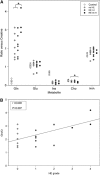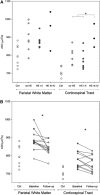Brain magnetic resonance spectroscopy in episodic hepatic encephalopathy
- PMID: 23168529
- PMCID: PMC3564202
- DOI: 10.1038/jcbfm.2012.173
Brain magnetic resonance spectroscopy in episodic hepatic encephalopathy
Abstract
Brain magnetic resonance (MR) study has shown metabolic abnormalities and changes in water distribution of the brain tissue that may relate to the pathogenesis of hepatic encephalopathy (HE). We designed a study to investigate the disturbances in brain water and metabolites during episodic HE using a 3-T MR scanner. Cirrhotic patients with different grades of HE underwent MR during hospitalization (n=18). The MR was repeated at 6 weeks' follow-up (n=14). The results were compared with those of a group of healthy volunteers (n=8). During episodic HE, brain diffusion-weighted imaging showed a high apparent diffusion coefficient (ADC) (12% to 14%) that decreased during follow-up (-1% to -4%). These disturbances were accompanied by high glutamine (581%), low choline (-31%), and low myo-inositol (-86%) peaks on MR spectroscopy. In overt HE, patients showed high glutamine that decreased during follow-up (-22%). In addition, these patients exhibited a rise in plasma S100 beta and enlargement of brain white-matter lesions. In conclusion, several disturbances detected by MR support the presence of impaired brain water homeostasis during episodic HE. Although astrocytes have a major role in this condition, brain edema during episodic HE may be extracellular and does not appear to be directly responsible for the development of neurologic manifestations.
Figures





Similar articles
-
Brain edema dynamics in patients with overt hepatic encephalopathy A magnetic resonance imaging study.Neuroimage. 2010 Aug 15;52(2):481-7. doi: 10.1016/j.neuroimage.2010.04.260. Epub 2010 May 6. Neuroimage. 2010. PMID: 20451628
-
Differential impact of hyponatremia and hepatic encephalopathy on health-related quality of life and brain metabolite abnormalities in cirrhosis.J Hepatol. 2013 Sep;59(3):467-73. doi: 10.1016/j.jhep.2013.04.023. Epub 2013 May 7. J Hepatol. 2013. PMID: 23665182 Free PMC article.
-
Magnetization transfer ratio values and proton MR spectroscopy of normal-appearing cerebral white matter in patients with liver cirrhosis.AJNR Am J Neuroradiol. 2001 Jun-Jul;22(6):1137-42. AJNR Am J Neuroradiol. 2001. PMID: 11415910 Free PMC article.
-
Brain metabolism in patients with hepatic encephalopathy studied by PET and MR.Arch Biochem Biophys. 2013 Aug 15;536(2):131-42. doi: 10.1016/j.abb.2013.05.006. Epub 2013 May 30. Arch Biochem Biophys. 2013. PMID: 23726863 Review.
-
MR imaging findings in hepatic encephalopathy.AJNR Am J Neuroradiol. 2008 Oct;29(9):1612-21. doi: 10.3174/ajnr.A1139. Epub 2008 Jun 26. AJNR Am J Neuroradiol. 2008. PMID: 18583413 Free PMC article. Review.
Cited by
-
Hepatic Encephalopathy: From the Pathogenesis to the New Treatments.ISRN Hepatol. 2014 Jun 4;2014:236268. doi: 10.1155/2014/236268. eCollection 2014. ISRN Hepatol. 2014. PMID: 27335836 Free PMC article. Review.
-
New Insight in Hyperinsulinism/Hyperammonemia Syndrome by Magnetic Resonance Imaging and Spectroscopy.Brain Sci. 2022 Mar 15;12(3):389. doi: 10.3390/brainsci12030389. Brain Sci. 2022. PMID: 35326344 Free PMC article.
-
Brain Edema in Chronic Hepatic Encephalopathy.J Clin Exp Hepatol. 2019 May-Jun;9(3):362-382. doi: 10.1016/j.jceh.2019.02.003. Epub 2019 Feb 19. J Clin Exp Hepatol. 2019. PMID: 31360029 Free PMC article. Review.
-
Benefits of Early Treatment for Patients with Hepatic Myelopathy Secondary to TIPS: A Retrospective Study in Northern China.Sci Rep. 2018 Oct 12;8(1):15184. doi: 10.1038/s41598-018-33216-1. Sci Rep. 2018. PMID: 30315180 Free PMC article.
-
Alcohol's Effects on the Brain: Neuroimaging Results in Humans and Animal Models.Alcohol Res. 2017;38(2):183-206. Alcohol Res. 2017. PMID: 28988573 Free PMC article. Review.
References
-
- Cordoba J, Minguez B. Hepatic encephalopathy. Semin Liver Dis. 2008;28:70–80. - PubMed
-
- Norenberg MD. Astroglial dysfunction in hepatic encephalopathy. Metab Brain Dis. 1998;13:319–335. - PubMed
-
- Zemtsova I, Gorg B, Keitel V, Bidmon HJ, Schror K, Haussinger D. Microglia activation in hepatic encephalopathy in rats and humans. Hepatology. 2011;54:204–215. - PubMed
-
- Palomero-Gallagher N, Bidmon HJ, Cremer M, Schleicher A, Kircheis G, Reifenberger G, et al. Neurotransmitter receptor imbalances in motor cortex and basal ganglia in hepatic encephalopathy. Cell Physiol Biochem. 2009;24:291–306. - PubMed
Publication types
MeSH terms
Substances
LinkOut - more resources
Full Text Sources
Medical
Molecular Biology Databases
Miscellaneous

